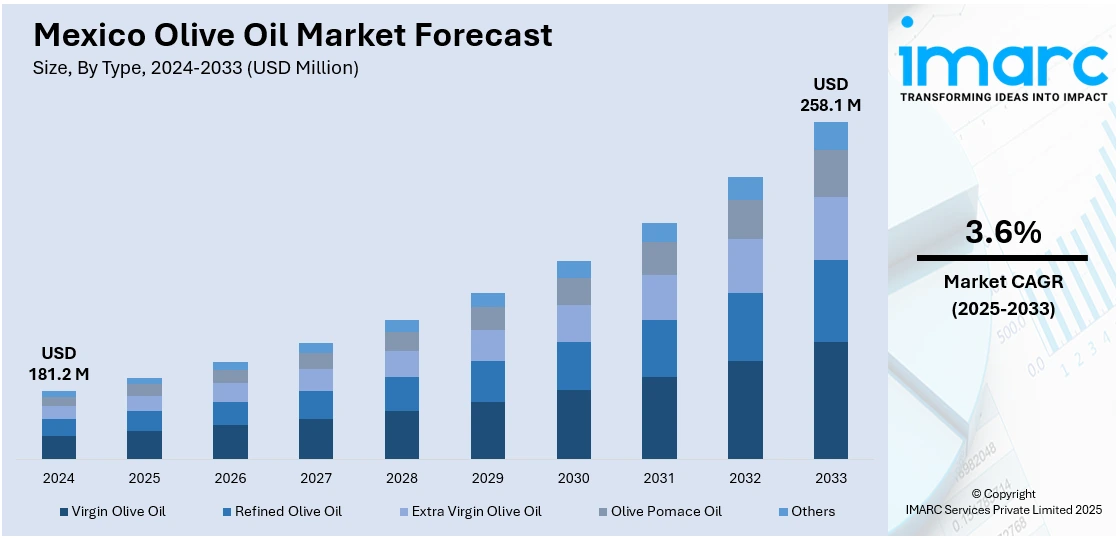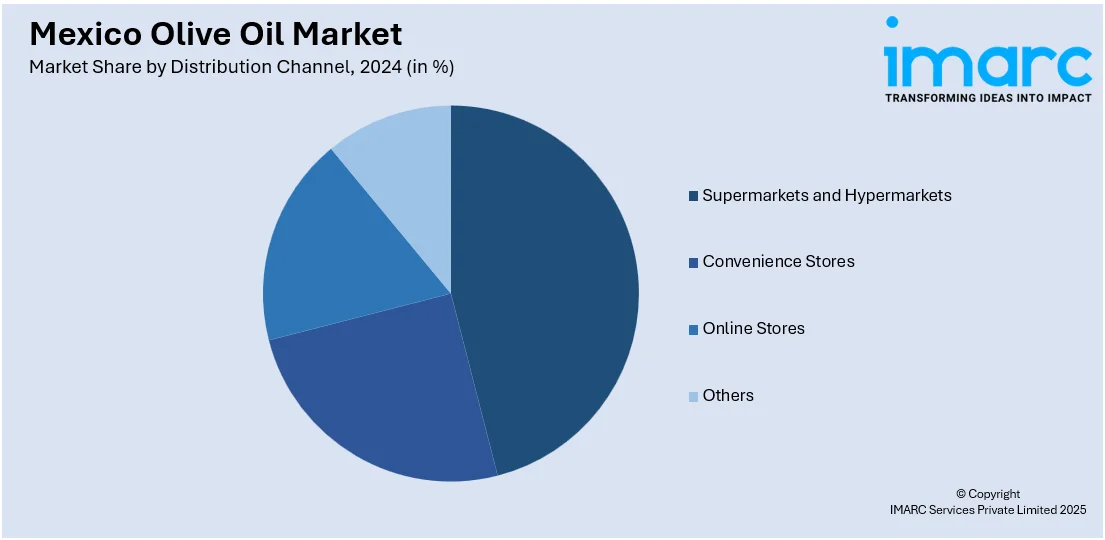
Mexico Olive Oil Market Size, Share, Trends and Forecast by Type, Distribution Channel, Application, and Region, 2025-2033
Mexico Olive Oil Market Size, Share & Trends
The Mexico olive oil market size reached USD 181.2 Million in 2024. Looking forward, IMARC Group expects the market to reach USD 258.1 Million by 2033, exhibiting a growth rate (CAGR) of 3.6% during 2025-2033. The market is fueled by rising health consciousness, changing eating habits toward Mediterranean-style consumption, and growing demand for natural, heart-healthy cooking oils. Culinary creativity and enhanced popularity of international food patterns also fuel the market growth among urban and health-conscious consumer groups.
|
Report Attribute
|
Key Statistics
|
|---|---|
|
Base Year
|
2024 |
|
Forecast Years
|
2025-2033
|
|
Historical Years
|
2019-2024
|
| Market Size in 2024 | USD 181.2 Million |
| Market Forecast in 2033 | USD 258.1 Million |
| Market Growth Rate 2025-2033 | 3.6% |
Mexico Olive Oil Market Trends:
Growing Health Consciousness and Dietary Shifts
There is an observable trend in Mexico toward improved eating habits, with consumers becoming more inclined toward olive oil as a preferred fat for cooking. This is driven by increased health awareness about the benefits of olive oil, including its ability to lower the risk of heart disease and its antioxidant-rich content. With Mexican consumers becoming increasingly health-aware, alternatives to conventional cooking oils are becoming more popular with them, provided they fit within a balanced diet. Olive oil, especially extra virgin types, is becoming popular for its medicinal benefits and also for its use across different culinary forms. This trend is part of a larger movement toward the inclusion of functional foods in everyday diets, as consumers seek to make informed decisions that promote long-term health, which further indicates a larger influence on the Mexico olive oil market outlook.

Cultural Integration and Culinary Popularity
The cultural integration of olive oil into Mexican cooking is becoming more profound, with a combination of traditional cooking techniques and contemporary dietary trends. Although olive oil has been a Mediterranean diet staple for centuries, its use in Mexico is changing, particularly in cities where international food influences are prevalent, which in turn largely contributes to themarket growth. Olive oil is being tested by home cooks and chefs alike in Mexican recipes, adding flavor and a modern twist to traditional dishes. This gastronomic experimentation is helping to foster a wider use of olive oil, as a health-conscious option and also as a tasty ingredient that enhances the rich fabric of Mexican cuisine. As olive oil becomes deeply rooted in daily cooking, its presence in Mexican homes is likely to continue expanding, proliferating home cooking as well as restaurant menus, thus impelling the Mexico olive oil market growth.
Challenges in Domestic Production and Import Reliance
In spite of the growing demand for olive oil in Mexico, domestic production is not without challenges that make it difficult for the country to satisfy consumption demands on its own. Climatic conditions, small areas for cultivation, and competition with other agricultural priorities have been some of the factors leading to a drop in local olive oil production over the years. Consequently, Mexico depends largely on imports to meet local demand, especially from nations with mature olive oil industries. This dependency on imported olive oil poses challenges in terms of supply chain stability, price volatility, and quality assurance requirements. To mitigate these challenges, there is increasing interest in programs focused on reviving local olive farming and production. Such initiatives could involve studying climate-resistant olive varieties, agricultural infrastructure investment, and pro-farmer policies, all aimed toward lessening reliance on imports and creating an autonomous Mexico olive oil market share.
Mexico Olive Oil Market Segmentation:
IMARC Group provides an analysis of the key trends in each segment of the market, along with forecasts at the regional level for 2025-2033. Our report has categorized the market based on type, distribution channel, and application.
Type Insights:
- Virgin Olive Oil
- Refined Olive Oil
- Extra Virgin Olive Oil
- Olive Pomace Oil
- Others
The report has provided a detailed breakup and analysis of the market based on the type. This includes virgin olive oil, refined olive oil, extra virgin olive oil, olive pomace oil, and others.
Distribution Channel Insights:

- Supermarkets and Hypermarkets
- Convenience Stores
- Online Stores
- Others
The report has provided a detailed breakup and analysis of the market based on the distribution channel. This includes supermarkets and hypermarkets, convenience stores, online stores, and others.
Application Insights:
- Food and Beverage
- Pharmaceuticals
- Cosmetics
- Others
The report has provided a detailed breakup and analysis of the market based on the application. This includes food and beverage, pharmaceuticals, cosmetics, and others.
Regional Insights:
- Northern Mexico
- Central Mexico
- Southern Mexico
- Others
The report has also provided a comprehensive analysis of all the major regional markets, which include Northern Mexico, Central Mexico, Southern Mexico, and others.
Competitive Landscape:
The market research report has also provided a comprehensive analysis of the competitive landscape. Competitive analysis such as market structure, key player positioning, top winning strategies, competitive dashboard, and company evaluation quadrant has been covered in the report. Also, detailed profiles of all major companies have been provided.
Mexico Olive Oil Market News:
- In April 2025, Santa Fe Olive Oil & Balsamic Co. located at 116 Don Gaspar Ave. declared that it is working on increasing the store's downtown visibility by more than twofold. The company is moving into a related area, which means its space will increase from around 1,000 to 2,200 square feet.
Mexico Olive Oil Market Report Coverage:
| Report Features | Details |
|---|---|
| Base Year of the Analysis | 2024 |
| Historical Period | 2019-2024 |
| Forecast Period | 2025-2033 |
| Units | Million USD |
| Scope of the Report |
Exploration of Historical Trends and Market Outlook, Industry Catalysts and Challenges, Segment-Wise Historical and Future Market Assessment:
|
| Types Covered | Virgin Olive Oil, Refined Olive Oil, Extra Virgin Olive Oil, Olive Pomace Oil, Others |
| Distribution Channels Covered | Supermarkets and Hypermarkets, Convenience Stores, Online Stores, Others |
| Applications Covered | Food and Beverage, Pharmaceuticals, Cosmetics, Others |
| Regions Covered | Northern Mexico, Central Mexico, Southern Mexico, Others |
| Customization Scope | 10% Free Customization |
| Post-Sale Analyst Support | 10-12 Weeks |
| Delivery Format | PDF and Excel through Email (We can also provide the editable version of the report in PPT/Word format on special request) |
Key Questions Answered in This Report:
- How has the Mexico olive oil market performed so far and how will it perform in the coming years?
- What is the breakup of the Mexico olive oil market on the basis of type?
- What is the breakup of the Mexico olive oil market on the basis of distribution channel?
- What is the breakup of the Mexico olive oil market on the basis of application?
- What is the breakup of the Mexico olive oil market on the basis of region?
- What are the various stages in the value chain of the Mexico olive oil market?
- What are the key driving factors and challenges in the Mexico olive oil market?
- What is the structure of the Mexico olive oil market and who are the key players?
- What is the degree of competition in the Mexico olive oil market?
Key Benefits for Stakeholders:
- IMARC’s industry report offers a comprehensive quantitative analysis of various market segments, historical and current market trends, market forecasts, and dynamics of the Mexico olive oil market from 2019-2033.
- The research report provides the latest information on the market drivers, challenges, and opportunities in the Mexico olive oil market.
- Porter's five forces analysis assist stakeholders in assessing the impact of new entrants, competitive rivalry, supplier power, buyer power, and the threat of substitution. It helps stakeholders to analyze the level of competition within the Mexico olive oil industry and its attractiveness.
- Competitive landscape allows stakeholders to understand their competitive environment and provides an insight into the current positions of key players in the market.
Need more help?
- Speak to our experienced analysts for insights on the current market scenarios.
- Include additional segments and countries to customize the report as per your requirement.
- Gain an unparalleled competitive advantage in your domain by understanding how to utilize the report and positively impacting your operations and revenue.
- For further assistance, please connect with our analysts.
 Request Customization
Request Customization
 Speak to an Analyst
Speak to an Analyst
 Request Brochure
Request Brochure
 Inquire Before Buying
Inquire Before Buying




.webp)




.webp)












